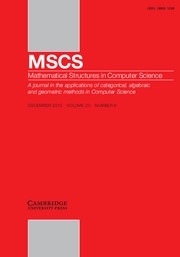Article contents
Schnorr dimension
Published online by Cambridge University Press: 11 October 2006
Abstract
Following Lutz's approach to effective (constructive) dimension, we define a notion of dimension for individual sequences based on Schnorr's concept(s) of randomness. In contrast to computable randomness and Schnorr randomness, the dimension concepts defined via computable martingales and Schnorr tests coincide, that is, the Schnorr Hausdorff dimension of a sequence always equals its computable Hausdorff dimension. Furthermore, we give a machine characterisation of the Schnorr dimension, based on prefix-free machines whose domain has computable measure. Finally, we show that there exist computably enumerable sets that are Schnorr (computably) irregular: while every c.e. set has Schnorr Hausdorff dimension 0, there are c.e. sets of computable packing dimension 1, which is, from Barzdiņš' Theorem, an impossible property for the case of effective (constructive) dimension. In fact, we prove that every hyperimmune Turing degree contains a set of computable packing dimension 1.
- Type
- Paper
- Information
- Copyright
- 2006 Cambridge University Press
- 3
- Cited by


